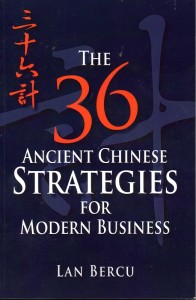Book Review: The 36 Ancient Chinese Strategies for Modern Business by Lan Bercu
Disclaimer: I received this book as a Goodreads giveaway on the premise that I would review it.
Beginning some time in the late 1970s, when it became obvious that Japan had become an economic powerhouse, American businesses began taking an interest in Asian philosophies that might explain why companies from those areas were doing so well, especially in industries where America was faltering. Thus, books for business explicating on The Five Rings, The Art of War and so forth have been written and often sold well.
This is the latest book in that tradition. The author was born and raised in Vietnam, where The 36 Strategies, a text on warfare believed to have been compiled during China’s Warring States period, is read by schoolchildren. She has since found the information included helpful in her career as a speaker on business and international matters.
The main text is divided into thirty-six short chapters, one for each strategy. Each starts with a short story about ancient Chinese warfare, then one or more examples of how modern businesses have implemented these strategies, whether by name or by chance. This is followed by translation into more basic tips, and questions for the business to ask itself based on the strategy.
Some of the strategies have poetic sounding titles, like “slough off the cicada’s golden shell” or “borrow a corpse to resurrect a soul”, while others are more plain-spoken, like “kill with a borrowed knife.” The strategies themselves, however, tend to be simple to understand, if sometimes difficult to apply to a given situation. That last bit is why they’re arranged by type; some are better when you have a clear advantage, others when you’re on the defensive or in a losing position.
It should be noted that the more literal applications of some of these strategies to business, such as “replace the beam with rotted timbers” and “deck the tree with false blossoms” may be considered unethical, and in some cases are outright illegal. The author points out that businesses (and customers) should be aware of these strategies anyway, to help defend against them.
The short chapters and copious examples make this a good read for the busy person on the go; this is one time I would suggest buying the e-book version. The book comes with an ad for the author’s services, bibliography and an index.
The utility of this book will depend on whether you already have another of the books relating the 36 strategies to business. If so, you may not need this one. This book also has a lot of synergy with The Art of War, so you may want to invest in one of the business books that concentrate on that text as well.
In war, do not repeat the tactics that have gained you one victory. Rather, let your methods be determined by the infinite variety of circumstances. — Sun Tzu


Mmmmm….war strategies for business….don’t think that one is for me! I prefer a more soulful approach.
The author reminds us that unlike war, business is not a zero-sum game and sometimes it’s better not to go for the kill. In specific, a business can gain much goodwill by *not* using the “loot a burning house” stratagem. (That is, not gouging customers when they have a crisis situation and need your product.)